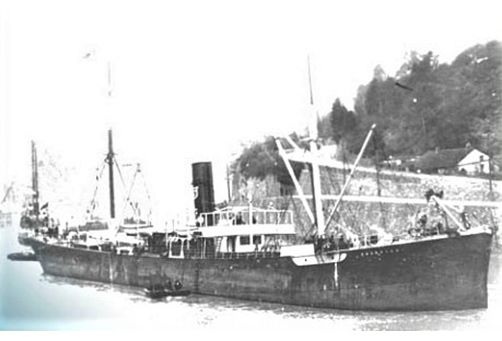
The wreck of the Carbonero, or ‘Thordisa,’ was an Italian steamship built in 1888, measuring 88 meters in length, renamed in 1913 as ‘Lilla.’ It was sunk by the German submarine U-35 on October 13, 1917, and rests on a sandy bottom in a sailing position.
The story of this sinking says that it was shelled by the German submarine when it came to the aid of the steamship ‘Doris,’ which was attacked and sunk in the area of Bajo de Fuera that same day, and finally sunk in its current position, just over 3 miles from the port of Tomas Maestre in La Manga.
It is currently known as “Carbonero” due to the large amount of coal found in one of its holds, although it is unknown whether this was used for the ship’s own propulsion or was the cargo it was transporting at the time of the sinking.
It is one of the most visited wrecks by lovers of sunken ships. It is located between 36 and 45m deep, about two miles NE of Isla Grosa. The sandy bottom that surrounds it is heavily inhabited by large sea cucumbers (Holothuria), numerous bonellia viridis, and some algae. As for fauna, it is easy to observe large leerfish (seriola dumerillis), groupers (epinephelus guaza), huge conger eels (conger conger), and countless species of medium and large size. The ocean sunfish (mola mola) is a regular visitor to the wreck and curiously observes the divers who frequent it. It is also not difficult to encounter a school of barracuda (esphyraena sphyraena).
The deck of the ship is at a depth of 36/40 meters and is where most of the dives take place, making it unnecessary to leave it and go to the bottom, because, except for taking photos, it is not really worth it. The wreck is not marked, and is frequented by fishermen, so special caution must be taken with abandoned nets on the wreck. The ship is practically split in two and although it is possible to penetrate it, care must be taken with the tangle of nets, fishing lines and hooks that surround the boat.
It is very deteriorated, perhaps as a direct consequence of the depth charges to which it has been subjected for the illegal fishing of the large fish that live there and possibly to demolition practices carried out by the C.B.A.
In its stern, a third of the total length of the ship, there is a huge fissure that divides the wreck in two. However, accounts from divers who descended to the wreck in the 80s say that at this time it was whole.
These holes, with dimensions that invite the brave diver to penetrate it, can become true traps, even for the most seasoned and intrepid divers. This does not mean that we should refrain from entering the holds, but always with the watchful eye of our companions on the outside, and entering in turns, taking extreme caution once inside so as not to get caught and especially when leaving, as we go from a dimly lit place to the outside which is brighter and blinds us, preventing us from seeing possible fishing lines and loose ends in the hole of the exit.
To dive here: For your health and safety, it is important that you do this dive without being tired or in poor physical condition. The use of your own dive computer is mandatory. Gloves, a flashlight, and a knife are recommended. Proven experience in drift dives is essential for performing safety stops without a line and without fixed references.
Qualification: Experienced Advanced Diver, TEC45 recommended